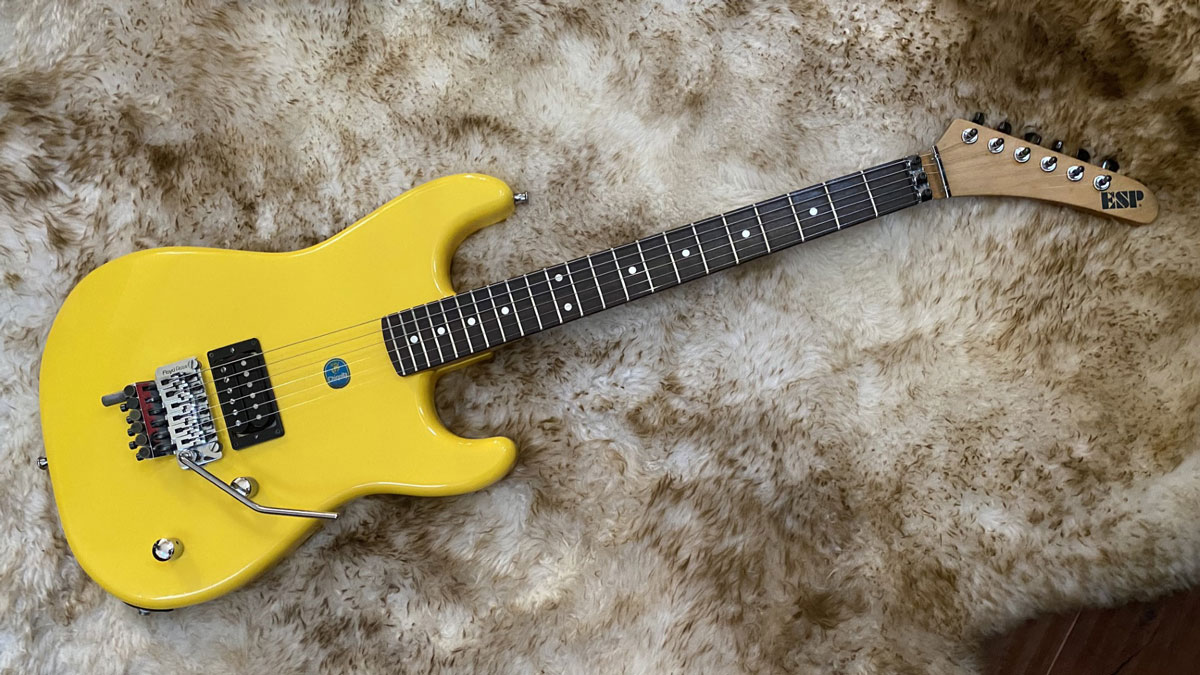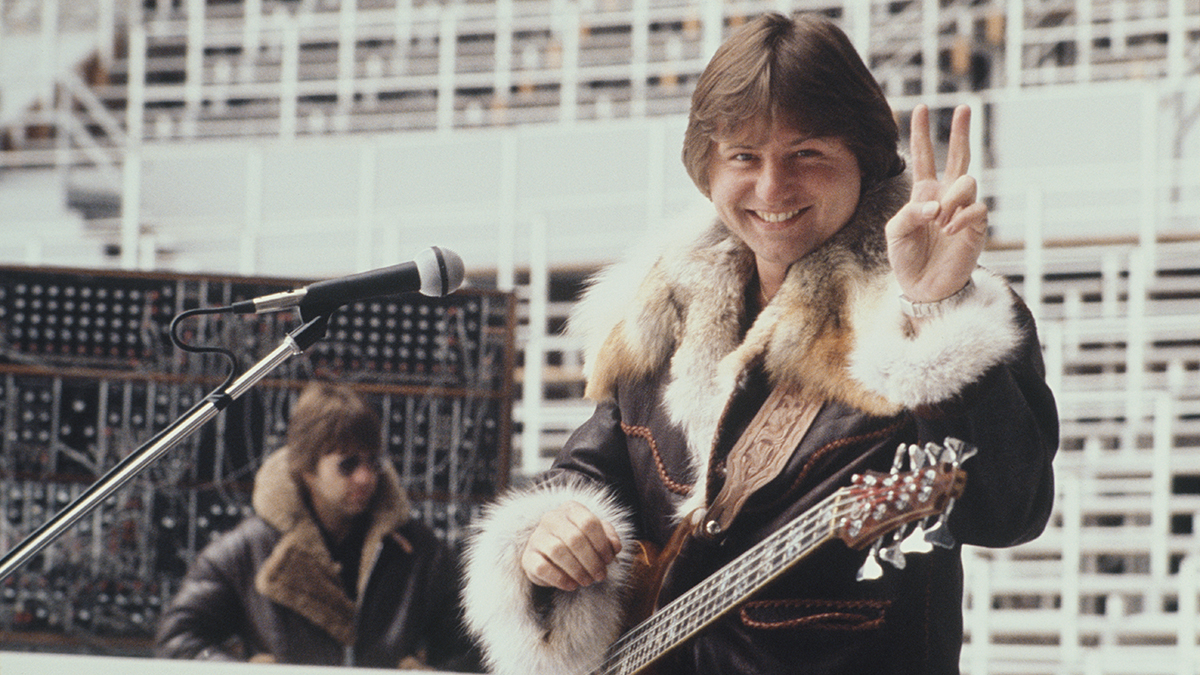“Gibson represented vintage makeup-era Kiss – Paul Stanley wanted me to be part of the new generation of guitar players”: How Bruce Kulick gave Kiss a hair-metal makeover with his iconic ESP ‘Banana’ guitar
By 1984, Kiss had ditched the makeup and recruited a hot new gunslinger, who was on the hunt for a six-string identity worthy of the Superstrat era. Kulick tells us why his beloved yellow shred machine was “special from the first power chord I hit”

While he was known to brandish myriad mad scientist axes with Kiss, in his pre-Kiss years, Bruce Kulick's guitar arsenal was geared more towards utility than flash.
But the era of hot-rodded guitars was underway by the time Kulick joined Kiss. And so, while his B.C. Rich and Gibson curios were reliable, a period-correct upgrade was surely in order.
"I knew I needed a Floyd Rose-equipped guitar," Kulick recalls. "I first had a Kubicki with a Floyd Rose. And when I got the call from Paul Stanley to do some studio work on Animalize, that Kubicki was the guitar I used. The neck was like a Fender, but the maple flame on the back of the neck was intense. It caused some movement that forced me to retire the guitar."
The Kubicki opened up a Pandora's box of hot-rodded axes. Intensifying matters, the studio work for Kiss quickly turned into full-scale touring.
"So, I get the call that Kiss needs me to go on tour in late 1984, and I had almost nothing to perform with," Kulick laughs. "But just before the opportunity, I acquired a black B.C. Rich Eagle, which worked for the vintage Kiss songs. But I needed something equipped with the Floyd Rose for the new styles of whammy bar wildness."
Recalling the next step in his Superstrat saga, Kulick tells us, "I went to 48th Street in NYC, and Sam Ash had a used Charvel in metallic blue, with one EMG pickup, and a Floyd Rose. It was the angle headstock years, with a Charvel Gold decal – very rare now to find. That guitar would become quite important for the Animalize tour."
After the final dates came to a close, Kulick began to assess his options, ultimately settling on the guitars that, in many ways, defined his tenure in Kiss.
All the latest guitar news, interviews, lessons, reviews, deals and more, direct to your inbox!
"In 1985, some friends that also lived in NYC introduced me to a new company called ESP that was primarily a parts company in Japan," Kulick says.
"ESP made necks and bodies much more Fender-like to me and were more comfortable than Charvel and Jackson guitars' flatter profiles. With Kiss being based in NYC then, ESP was perfect. I could pick necks, bodies, and parts in my desired colors. And I could challenge them with ideas and concepts of guitar finishes. They were growing, and together, along with other hot guitarists like George Lynch, we quickly put ESP on the map."
Still, while Kiss was once again a platinum-level band in the '80s, they were veterans compared to the young guns around them. Moreover, a considerable part of their lead guitar success had come from legacy brands like Gibson.
When asked if he felt trepidation challenging that established norm, Kulick quips, "Gibson guitars represented vintage makeup-era Kiss guitars. But in early December 1984, Paul [Stanley] said, 'You're the new guitarist of Kiss,' and wanted me to know the vintage material and be part of the new generation of guitar players. I was keenly aware of the balance between the makeup years and my non-makeup years. ESP would bring me all these options!"
With Stanley's blessing and ESP's open-mindedness, Kulick visited ESP's NYC facility, unknowingly creating a guitar that would become one of Kiss's most iconic guitars: The M-1 'Banana'.
The rosewood fingerboard is gorgeous and feels great in my hand. So good, in fact, I rarely had it on stage. It was a recording guitar
"I had the luxury of picking a body, neck, and the parts that would make the Superstrat to my liking," Kulick reveals. "But the fact that the yellow body and neck I chose – which in a short time became called the Banana guitar – was so good it became the template for my M-1 guitars."
The Banana was a looker, but did Kulick know it would lead him down a path of shred glory from the jump?
"It was special from the first power chord I hit," Kulick insists. "It's got great tone and playability, and in some ways a friendly [Kramer] Baretta neck profile. It's not as slim as some of my other M-1s, but it's not large, either. I can't explain it, and I've never felt another like it. The rosewood fingerboard is gorgeous and feels great in my hand. So good, in fact, I rarely had it on stage. It was a recording guitar."

As Kulick alluded, because he loved it so, he rarely replayed the Banana on the road. And that was fine, seeing as it featured heavily on Kiss's 1987 – and guitar-forward – album Crazy Nights, with Kulick even brandishing it on the album's back cover.
"Crazy Nights was the LP where it did most of the solos," he tells us. "But it was used on many Kiss LPs past that release. It was a great tool. All I can say is listen to No No No and Crazy Nights, and hear it. It's aggressive-feeling, and I played as such."
Ironically, while the Banana wasn't used on the road often, one of its more lovable and quirky touches is the Chiquita sticker adhered just under its strings, which was reportedly added as a joke by Kiss's then-road crew.
"It's the same sticker... it's looking a little tired," Kulick chuckles. "I was always concerned about it being lost or stolen. The only reason it wasn't stolen when the Kiss warehouse was robbed in '88 is that it was my 'A' guitar, and I wasn't gonna leave it in a storage warehouse."
Over three decades since it appeared on the back cover of Crazy Nights, reverence is still heaped the well-respected '80s relic's way. So much that many wonder if Kulick and ESP plan to reissue the Banana.
"We did a small run nine years ago," Kulick reminds us. "ESP could only offer the hockey stick on older vintage models. My small run was privately ordered and sold long ago, and I couldn’t make more. So, only with an updated headstock is it possible to offer an ESP Banana. But with the updated headstock... it's possible. I am still working with ESP on some ideas, but I'm taking my time as I love things to be perfect."
It goes without saying that Kulick's original yellow M-1 holds a lot of memories. Having skirted theft and having been held back from the rigors of the road, Kulick is hyper-aware of the Banana's significance to both his and Kiss's history.
"When I pick up that guitar today, it's still comfortable," Kulick smiles. "I feel confident playing it. But it comes down to the player's ability to make an instrument speak. A great guitar is a powerful tool for an artist, but giving a particular instrument credit for Kisstory isn't fair.
"But the fact that it's a great guitar, and I could do my best work with it, makes it special. I'm noticing that the frets are getting tired, but for now, it's the same as it was in the '80s. Long live the Banana!"
Andrew Daly is an iced-coffee-addicted, oddball Telecaster-playing, alfredo pasta-loving journalist from Long Island, NY, who, in addition to being a contributing writer for Guitar World, scribes for Bass Player, Guitar Player, Guitarist, and MusicRadar. Andrew has interviewed favorites like Ace Frehley, Johnny Marr, Vito Bratta, Bruce Kulick, Joe Perry, Brad Whitford, Tom Morello, Rich Robinson, and Paul Stanley, while his all-time favorite (rhythm player), Keith Richards, continues to elude him.



